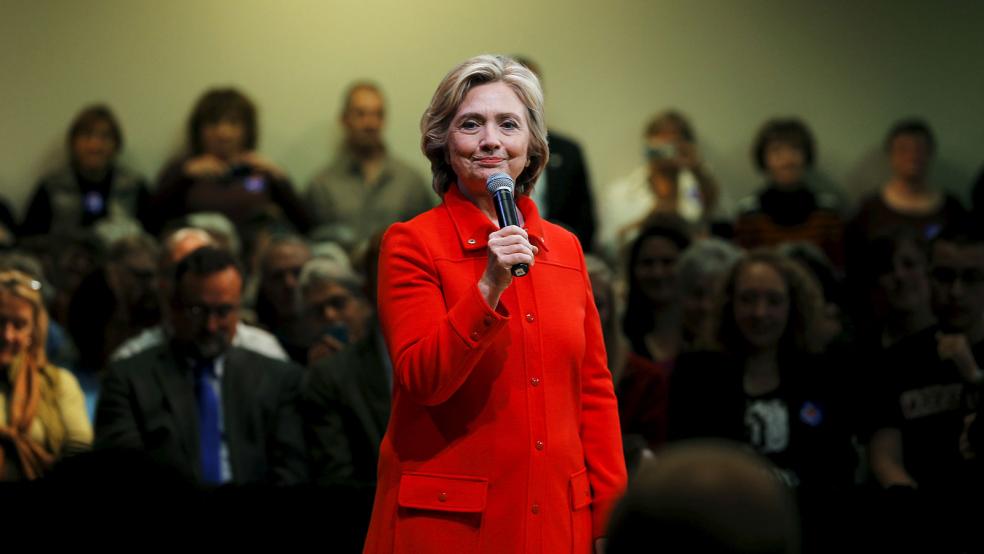Hillary Clinton previewed her $275 billion infrastructure plan during a campaign event in Boston on Sunday with construction workers, labor leaders and Democratic Mayor Martin J. Walsh, who endorsed her candidacy. “Investing in infrastructure makes our economy more productive and competitive across the board,” she said in kicking off a week of appearances and announcements geared to creating new jobs.
Clinton’s proposal is two-pronged: It would rely on $250 billion of direct federal expenditures for highways, bridges, tunnels and other major projects, and $25 billion more for a national infrastructure bank designed to leverage public and private investments into billions of dollars of fresh low-interest loans and other incentives for construction projects.
Related: The House Resorts to More Gimmicks to Pass $325 Billion Highway Bill
The lion’s share of this additional federal spending on infrastructure would be offset by closing pricey corporate tax loopholes, including tax inversion provisions that allow major corporations to avoid high U.S. tax rates by moving their headquarters overseas while retaining their material operations in this country. The pharmaceutical giant Pfizer announced last week that it was doing just that in a planned merger with Allergan to take advantage of much lower corporate taxes in Ireland.
The remainder of the financing for Clinton’s infrastructure proposal would come from a new infrastructure bank that would put up federal dollars to attract private investments to help bankroll highway, bridge, mass transit and other construction projects to spur economic growth.
“Investing in infrastructure makes tremendous sense, both because it creates jobs that pay above median wages and because it improves overall productivity, which leads to higher incomes across the broader economy,” Jake Sullivan, a policy adviser to the Clinton campaign, told The Washington Post over the weekend.
According to the White House Council of Economic Advisers, every $1 billion of expenditures on infrastructure create 13,000 new jobs – many of them “good-paying, middle-class jobs.” However, conservative groups including the Heritage Foundation and the Cato Institute are critical of this approach, saying it is an inefficient way to create jobs and subject to government waste.
Related: Clinton Courts Coal Country with $30 Billion Infrastructure Plan
There has long been an element of fiscal fantasy when it comes to financing new highways, bridges and other infrastructure. With lawmakers petrified of the consequences of raising the 18.4-cents a gallon federal gasoline tax despite two decades of inflationary erosion to its buying power, Congress has relied on a series of bookkeeping maneuvers and budgetary gimmicks to keep the federal transportation program limping along.
The House and Senate appear to be close this week to agreement on a new, six-year, $325 billion highway and transportation bill that contains only enough funding for three years. And most of those funds likely will come from dipping into the Federal Reserve Board’s capital surplus account, tweaking provisions of the federal tax code and even transferring money from the Leaking Underground Storage Tank and Sport Fish Restoration and Boating trust funds.
Clinton’s approach may be just as iffy in fiscal terms. Clinton is attempting to tap into broad Democratic support for a new round of major stimulus spending to keep the economy on track to recovery. However, the magnitude of her proposal pales in comparison to the $1 trillion of new infrastructure spending proposed earlier this year by her chief Democratic rival, Sen. Bernie Sanders of Vermont, who would finance it by raising taxes on corporations and wealthier Americans.
Clinton has chided Sanders for being too quick to turn to tax hikes to solve every problem and fund every new initiative. Yet if her approach sounds oddly familiar, that’s because it is.
Related: Congress Uses Accounting Gimmicks to Fund Highway Bill
Key elements of the former secretary of state’s plan have been proposed many times before, but with little if anything to show for it. That doesn’t mean Clinton shouldn’t try again – and arguably she might have a chance to push through her plan if she is elected president and Democrats make gains in the House and Senate. However, if past is prologue, then it suggests that her latest major spending proposal is premised on shaky fiscal ground.
Take her tax-loophole closing strategy for example. President Obama and House Speaker Paul D. Ryan (R-WI), both beat her to this idea early this year, only to see their efforts to link serious tax reform to highway and other infrastructure spending fizzle amid partisan tensions and suspicions.
Ryan, who was then chair of the Ways and Means Committee, argued in February that if properly crafted, major tax reform this year could help shake loose many billions of dollars in revenues needed to pop up the near-bankrupt Highway Trust Fund. At the same time, the Obama administration proposed a one-time 14 percent tax on nearly $2 trillion of foreign earnings as a way to fund infrastructure projects.
Under Obama’s “repatriation” approach, major companies stashing income in safe havens would have a one-time opportunity to pay taxes on overseas earnings at the much lower 14 percent tax rate. In addition, the proposal would impose a permanent 19-percent tax on foreign earnings. The Obama proposal was designed to raise an estimated $238 billion in the coming years to underwrite new infrastructure program, with an additional $240 billion coming from the current federal tax on gas and other revenue sources.
Ryan and Obama both eventually gave up on their plans, acknowledging that nothing so complex and controversial would stand a chance of passage, at least until after the 2016 election.
As for Clinton’s infrastructure bank proposal, that is an evergreen that dates back to the 1980s, one that generated interest among labor and business groups but that never quite caught on with either party. While the proposals varied over the years, they were mostly premised on the notion that highway and bridge construction can be made much cheaper through the use of low-interest loans and grants instead of direct spending from the general fund or Highway Trust Fund.





